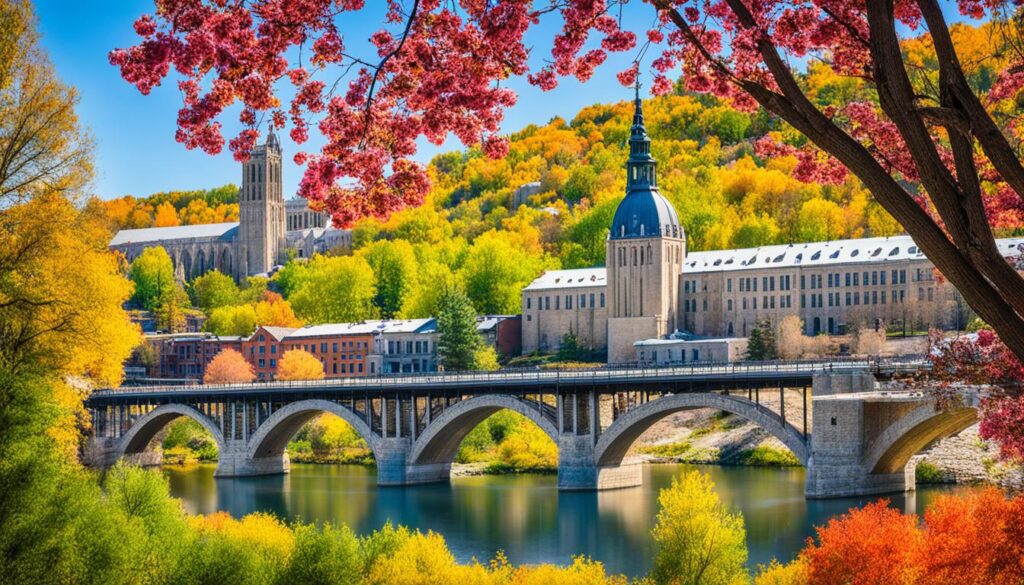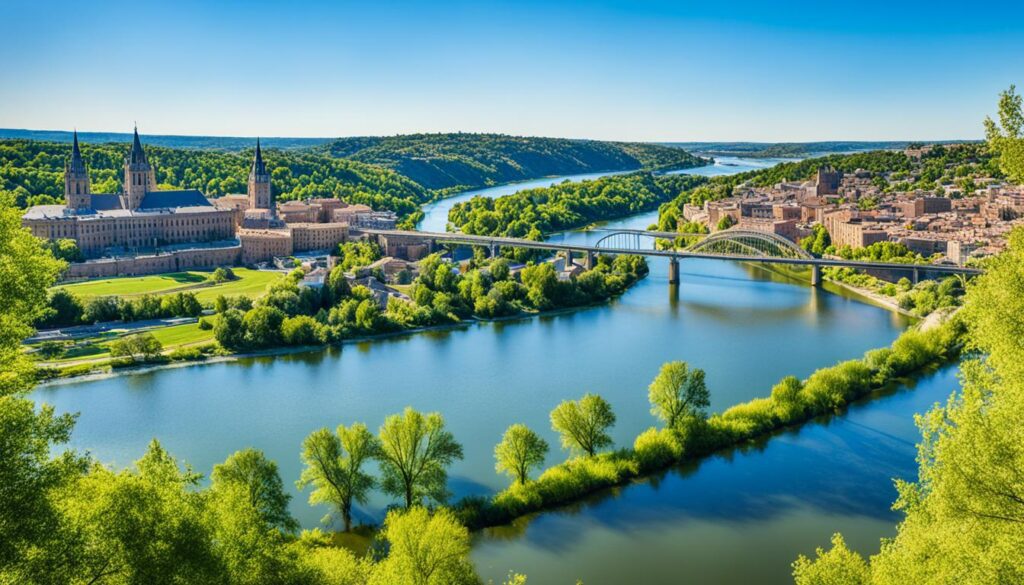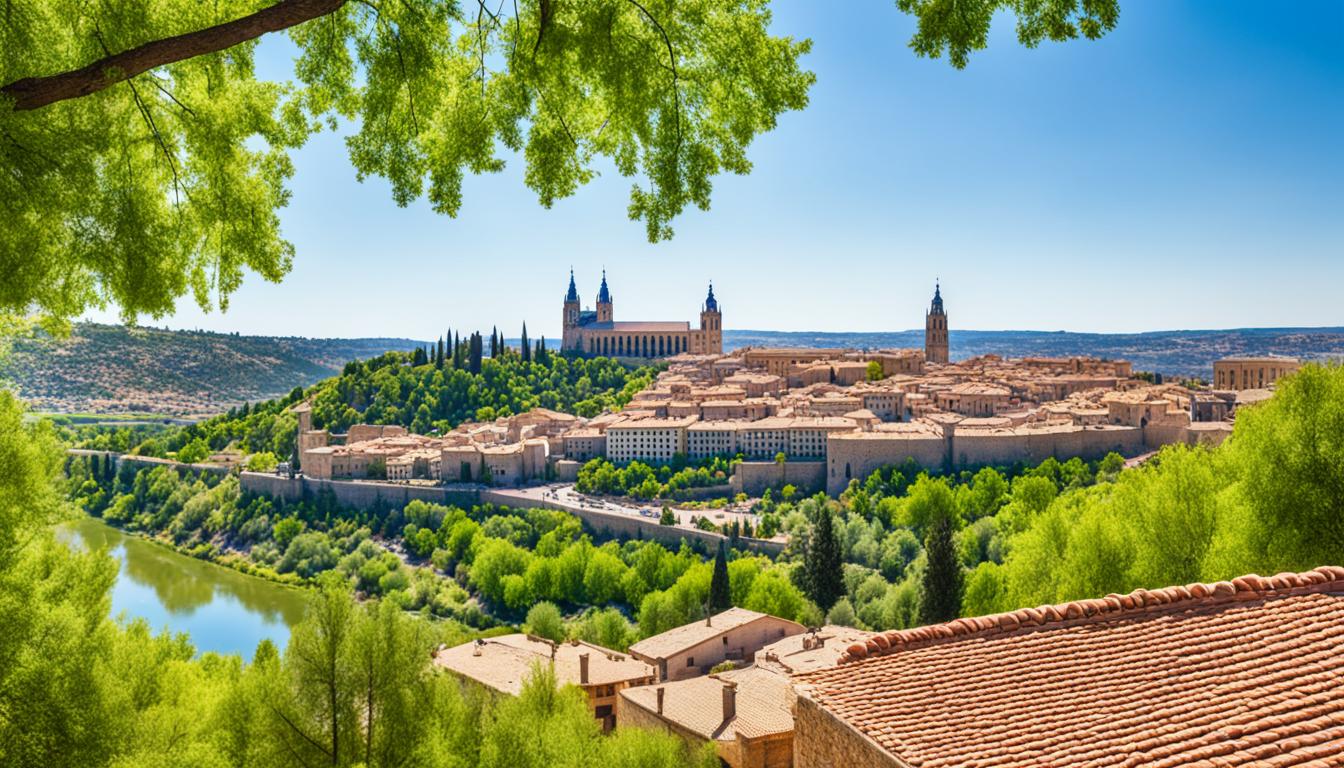Toledo sits in the heart of Spain, known for its stunning architecture and rich culture. But, knowing the city’s weather is key to enjoying your trip. Toledo’s climate changes a lot, from hot summers to cold winters.
Key Takeaways
- Toledo, Spain has a continental climate with significant temperature fluctuations throughout the year.
- Rainfall in Toledo is generally low, with a marked summer drought and higher precipitation in spring and late autumn.
- Winters in Toledo are cool with frequent frosts, while summers can be extremely hot, with temperatures occasionally exceeding 40°C (104°F).
- Toledo is ranked as the third sunniest city in Spain, with an average of 3,040 hours of sunshine per year.
- The city’s location on a plateau in central Spain, surrounded by the Tagus River, influences its unique weather patterns.
Introduction to Toledo’s Weather Patterns
The city of Toledo is a treasure in the Iberian Peninsula. It’s known for its stunning architecture and rich culture. Located about 70 kilometers south of Madrid, Toledo sits on a hill by the Tagus River. This spot has greatly influenced its toledo spain weather and climate.
Overview of the City’s Geographical Location
Toledo sits high on “La Meseta,” over 500 meters above sea level. This spot affects its weather. The city is close to the Tagus River and a canyon, making its climate unique. These elements create a special mix of geography and weather.
Factors Influencing Toledo’s Climate
- Elevation: Toledo’s high spot on “La Meseta” changes its temperature and how much rain it gets.
- Proximity to the Tagus River: The river and canyon make the weather in Toledo special. They help create fog and affect humidity.
- Latitude: Being in the center of the Iberian Peninsula, Toledo has a climate that’s different from the coast.
Toledo’s weather is shaped by its geography and topography. This makes its climate unique in the Iberian Peninsula. Knowing these factors helps plan a visit and enjoy the weather.
toledo spain weather
Toledo, Spain, a city by the Tagus River, has a special toledo spain weather. Its weather comes from its location and the climate. The Koppen climate classification says it has a cold semi-arid climate (BSk). This means it gets little rain and has big changes in the seasons.
Köppen Climate Classification for Toledo
The Koppen climate classification says Toledo’s climate is cold semi-arid (BSk). This means it doesn’t get much rain, mostly in spring and late autumn. The toledo rainfall and drought patterns show a big drought in summer. July and August are the driest months, with humidity often under 50%.
Rainfall and Drought Seasonality
- Toledo gets about 342 mm (13.46 inches) of rain a year, similar to Arizona, USA.
- The summer is the driest, with July and August being the driest months.
- Spring and late autumn bring more rain, offering a break from the summer toledo drought.
The weather in toledo spain is shaped by the Koppen climate and the city’s rainfall and drought patterns. This creates a unique climate that affects the local area and helps plan outdoor activities and trips to the region.
Temperature Variations Throughout the Year
Toledo, Spain, sees big changes in temperatures all year. Its location and the climate make winter months quite different.
Cool Winters and Frosty Nights
In winter, Toledo’s temperatures swing a lot between day and night. Daytime highs are usually between 51.8°F and 57.2°F (11.5°C to 14°C). Nights can get as low as 34.3°F to 36.7°F (1.3°C to 2.6°C).
December and January are the coldest months. You might see toledo frosty nights and some light snow. But, it’s rare for Toledo to have more than one day below freezing a year.
The toledo temperature variations are shaped by its spot near the Tagus River and in the central Iberian Peninsula. This mix leads to big temperature differences between day and night. It also causes extreme temperatures in different seasons.
Summer Heat and Sunshine Hours
Toledo sits high on a hill, making it more open to the sun. This leads to higher temperatures in summer. Daytime highs can hit a hot 37°C (100°F), staying high even late into the night. Spain Tours says Toledo is the third sunniest city in Spain, with 3,040 hours of sunshine annually.
For about 20 days in July and 15 days in August, Toledo has clear blue skies. These hot summer months can be tough for visitors. The scorching summer heat and high temperatures are key things to think about when planning a trip.
Maximums Exceeding 40°C (104°F)
In June, Toledo’s average high is a warm 29.4°C (85°F). Sometimes, it can go over 40°C (104°F) in the summer peak. It’s smart to travel in groups, use air-conditioning, and drink plenty of water to handle the toledo summer heat.
Toledo’s Ranking as Spain’s Third Sunniest City
Toledo gets an average of 11 hours and 5 minutes of sunshine daily in June. This makes it one of the sunniest places in Spain. It’s a top spot for those who love the sun and beaches.
“The weather in Toledo is generally sunny, with an average of 25 to 29 days without rain in the summer months.”
Precipitation Levels and Rainy Seasons
Toledo, a city in central Spain, gets about 350 millimeters (13.8 inches) of rain each year on average. The city has rainy seasons in spring and autumn. These seasons bring most of the rain.
In spring, from mid-April to late May, Toledo gets 40 to 45 millimeters (1.6 to 1.8 inches) of rain over 7 days. This rain makes the city’s landscapes and gardens bloom. Autumn, from mid-September to mid-October, is also rainy, with similar amounts of rain as spring.
Winter in Toledo is mild, with lows sometimes around -5°C (23°F). Snow is rare, but there was a big snowfall in January 2021, with 30 to 40 centimeters (12 to 16 inches) of snow.
Summer, from June to August, is the driest time in Toledo. It gets about 20 to 25 millimeters (0.8 to 1 inch) of rain a month. This makes summer great for visiting Toledo’s historic sites and enjoying the outdoors.
| Month | Average Precipitation (mm) | Average Precipitation (inches) | Average Wet Days |
|---|---|---|---|
| January | 25 | 1 | 5 |
| February | 20 | 0.8 | 5 |
| March | 20 | 0.8 | 5 |
| April | 40 | 1.6 | 7 |
| May | 45 | 1.8 | 7 |
| June | 20 | 0.8 | 4 |
| July | 10 | 0.4 | 2 |
| August | 5 | 0.2 | 1 |
| September | 25 | 1 | 4 |
| October | 50 | 2 | 7 |
| November | 40 | 1.6 | 6 |
| December | 50 | 2 | 7 |
Toledo gets about 2,900 sunshine hours a year, making it one of Europe’s sunniest cities. This makes it a great place for travelers who want good weather and culture.
Spring and Fall Transitional Weather
Toledo, Spain, has hot summers and cool winters. But spring and fall are special. They bring moderate temperatures and blooming landscapes. This makes it perfect for those who want a comfy and pretty trip.
Moderate Temperatures and Blooming Landscapes
In spring, Toledo’s weather is nice, with temperatures from 16°C (60.8°F) in March to 29°C (84.2°F) in June. The city wakes up from winter, showing off its beautiful flowers. This makes it great for outdoor fun and seeing the sights.
Fall in Toledo is also great, with highs around 29°C (84.2°F) in September and cooling down to 16°C (60.8°F) by November. It’s a break from the summer heat. This lets visitors see the city’s old landmarks and cultural spots without the heat.
“Toledo’s spring and fall seasons are truly delightful, with moderate temperatures and blooming landscapes that make it an ideal time to visit and immerse yourself in the city’s rich history and vibrant culture.”
These seasons are less crowded than summer, so you can really feel like you’re part of the city. You can walk through the pretty streets, look at the beautiful buildings, or just enjoy the calm. Spring and fall in Toledo are magical times to visit.

Weather Phenomena and Fog Patterns
Toledo, Spain, is by the Tagus River and has a special weather event – fog. This fog can affect how clear it is outside and what you can do outside. It happens up to 6-8 days a month in winter, especially in December and January.
The Tagus River and its canyon help create these fog patterns. The river’s cool air meets the warmer air above, making thick fog. This fog can cover the city.
This fog changes how people in Toledo live and visit. It can make seeing the city’s old streets and landmarks hard. It might also change outdoor plans and events. But, the fog can also make Toledo seem magical and mysterious.
Knowing how the Tagus River affects the fog in Toledo is key for visitors. This knowledge helps them plan better and enjoy their visit more.
The Tagus River’s Impact on Toledo Fog Patterns
The Tagus River is central to Toledo’s fog. Its cool air mixes with the warmer air above, perfect for fog. This makes the fog stick around in the canyon.
- Increased Fog Frequency: Toledo can experience up to 6-8 days of fog per month during the winter season, particularly in December and January.
- Reduced Visibility: The dense fog can significantly impair visibility, making it more challenging to navigate the city’s historic streets and landmarks.
- Atmospheric Enchantment: The fog can also lend an air of mystery and enchantment to Toledo, creating a serene and captivating backdrop for exploring the city’s rich cultural heritage.
Knowing how the Tagus River affects Toledo’s fog is important for travelers. It helps them plan and enjoy their visit more.
Best Time to Visit Toledo
Toledo, Spain, has a Mediterranean climate that makes some seasons better than others for visiting. The best times are spring and fall. These seasons have nice weather and beautiful sights, perfect for seeing Toledo’s historic spots and outdoor activities.
Recommended Seasons for Optimal Weather Conditions
Toledo’s weather changes a lot, with hot summers, mild winters, and unpredictable times in between. Here are the best seasons to visit:
- Spring (April-May): Enjoy temperatures from 45°F to 65°F. You’ll see around 9-12 inches of rain and the city’s beautiful spring flowers.
- Fall (September-October): Experience mild weather, with temperatures between 45°F and 65°F. You’ll see 6-8 inches of rain and the fall colors.
Summers in Toledo get very hot, with temperatures over 95°F. Winters are cold, with frosts and sometimes snow, making it hard for sightseeing or outdoor fun.
The best time to visit Toledo is in spring and fall. These seasons offer great weather for exploring the city’s history, culture, and nature.

Packing Tips and Travel Essentials
Planning a trip to Toledo, Spain means packing the right clothes and gear for the weather. In the cooler winter, bring warm sweaters, jackets, and scarves. Also, don’t forget sturdy shoes or boots for the city’s rough terrain.
Summer brings warm weather, so pack light, breathable clothes and items like hats and sunscreen for sun protection. For spring and fall, pack clothes for both warm and cool weather. And, have rain gear ready for the occasional rain.
Clothing and Gear for Different Seasons in Toledo
- Winter: Warm layers (sweaters, jackets, scarves), sturdy shoes or boots
- Summer: Lightweight, breathable clothing, sun protection (hats, sunscreen)
- Spring and Fall: Mix of warm and cool weather attire, rain gear
Don’t forget to pack travel essentials like a phone charger, international outlet adapter, and a portable charging bank. Also, bring sunscreen, deodorant, first aid supplies, and any needed medications.
When visiting religious sites, dress modestly with your shoulders and knees covered. Comfortable, sweat-proof clothes are great for exploring the city’s streets and landmarks.
“Packing the right clothing and gear can make all the difference in enjoying your time in Toledo, Spain.”
Lastly, a light, packable rain jacket or poncho is handy for unexpected showers. Tailor your packing to the Toledo weather to fully enjoy this Spanish city.
Outdoor Activities and Weather Considerations
Toledo’s weather and landscape offer many outdoor activities for visitors. But, it’s key to think about the weather when planning your trips.
The spring and fall seasons are great for walking around the city. You can see the Toledo Cathedral and hike in the countryside. The weather is mild, and the landscapes are beautiful.
Summer in Toledo is hot and sunny. The long days and clear skies are nice for being outside. But, the heat might make you want to stay indoors. You can check out the museums and cultural spots instead.
In winter, Toledo is still worth visiting, even with the fog, frost, and snow. The cooler weather means you might need to plan your outdoor activities differently. But, the city has a special charm in winter too.
Toledo has outdoor activities for everyone, no matter the weather. Plan your visit and pack the right gear to enjoy this unique place.
“The weather is an active force, not just a background condition.” – Hannah Arendt
Conclusion
Toledo, Spain, is a city with a wide range of weather that draws in travelers. It sits by the Tagus River, making its climate unique. This location gives visitors a mix of seasons to enjoy.
The city has cool winters and hot summers with lots of sun. Toledo’s weather changes a lot, making it interesting for visitors. Knowing about the rainy seasons and how the Tagus River affects the fog helps plan trips. This way, visitors can enjoy Toledo’s best weather.
Spring and autumn bring beautiful flowers and mild weather. Summer is great for cultural events and festivals. Toledo has something for everyone, no matter the season. With the right clothes, visitors can easily enjoy Toledo’s sights, landmarks, and food, any time of the year.

